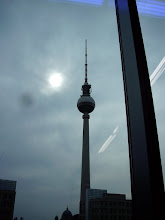For the Germans, November 9th reminds quite at the same time the advent of the Republic ( 1918 ), the pathetic " putsch of the Brewery " (1923), sinister " Crystal night " ( 1938 ) and the happy fall of the Wall ( 1989 ). At night from 9 till 10 November 1989, in front of the cameras of the whole world, young east and western Germans break the Wall of the shame which divides Berlin since August 13th, 1961, taking by surprise the leaders of both edges. Receptive to the policy of glasnost (transparency in Russian) introduced three years earlier by the Soviet leader Mikhaïl Gorbatchev, the Hungarian leaders were the first ones to lift the screed of communist lead. On May 2nd, 1989, they announce their intention to half-open their border with Austria. Hundreds of east Germans rush then in Hungary to pass soon on the West. In September, they are several thousands to run away so. In German Democratic Republic (GDR), in Leipzig then in the other cities of the country, the opponents of the communism leave the secret of the Lutheran temples and demonstrate in broad daylight. The power vacillates. Erich Honecker leaves the place with Egon Krenz, but a million demonstrators in East Berlin pull the collective resignation of the communist government on November 7th. Two days later, the government of GDR authorizes the east Germans to travel abroad " without any particular condition ". At the end of a few hours, the customs officers of Berlin, extended beyond by the hide of persons on the border, simply allow to pass them. That very evening, thousands of Berliners massed near the Wall and open one by one the borders in front of the redoubtable East German frontier officers who, this time, keep the weapon at the foot. The fall of the Wall (3,60 metres high, 160 kilometres long and 300 miradors) ends fifty years of separation and antagonisms between both parts of Germany, German Federal republic (FRG) and German Democratic Republic (GDR). In the general enthusiasm, nobody worries about the difficult next days of the reunification. Without loss of time, the Federal Chancellor Helmut Kohl imposes a monetary then political unification of both parts of Germany. The unity is official on October 3rd, 1990, one day which becomes the German national holiday. The French president François Mitterrand, noting the inevitable character of the reunification, is going to negotiate in return the sacrifice of the Deutschmark on the altar of the European monetary union. This project will result in the signature of the treaty of Maastricht on February 7th, 1992.
Subscribe to:
Post Comments (Atom)


No comments:
Post a Comment